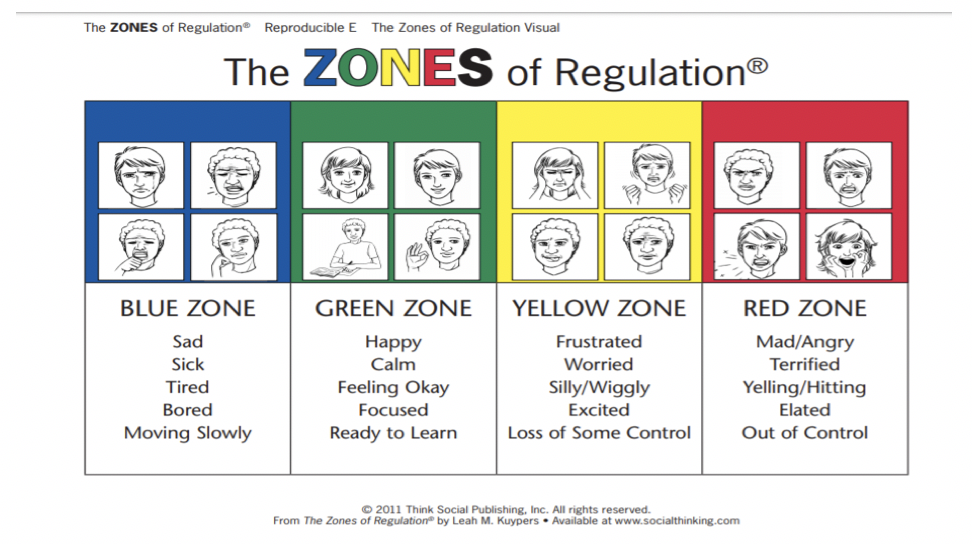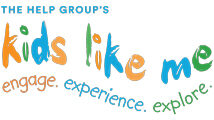Within our Help Group schools and our Kids Like Me (after-school therapeutic & enrichment) groups, we utilize the Zones of Regulation curriculum (by Leah Kyupers, OT) to help students develop self-regulation skills and emotional control. Given that stress and other difficult emotions are ever-present during the stay-at-home orders and Distance Learning, it is our goal to help caregivers implement some of the Zones language and activities at home as well.
Why Use the Zones?
While the overarching goal of the Zones curriculum is for students to develop self-awareness of their emotional states, the purpose or benefit of using the Zones language is four-fold:
- Identify emotions and level of “alertness”
- Know when and how to use coping strategies
- Problem solving for more positive outcomes
- Understand how behaviors influence others
The Zones Colors & Visuals

- Blue
- The Blue Zone is used to describe low states of alertness
- Feelings may include: sad, tired, sick, or bored
- The Blue Zone is associated with a blue “rest area” traffic sign
- The Blue Zone is used to describe low states of alertness
- Green
- The Green Zone represents a calm state of alertness.
- Feelings may include: happy, focused, content, or ready to learn
- The Green Zone is associated with a green “go” traffic sign
- The Green Zone is the optimal Zone and the one we try to get back to by using our coping strategies.
- The Green Zone represents a calm state of alertness.
- Yellow
- The Yellow Zone represents a heightened state of alertness and can serve as a warning
- Feelings may include: stress, frustration, anxiety, excitement, silliness, “the wiggles”, or nervousness
- The Yellow Zone is associated with a yellow “slow” or “proceed with caution” traffic sign
- The Yellow Zone represents a heightened state of alertness and can serve as a warning
- Red
- The Red Zone represents very intense emotions and often leads to difficulty with problem solving
- Feelings may include: elated, anger, rage, devastation, or terror
- The Red Zone is associated with a red “stop” traffic sign
- The Red Zone represents very intense emotions and often leads to difficulty with problem solving
If your child isn’t already familiar with the Zones, teach them these while modeling your own feeling states as well. For example, you could tell them, “This morning I woke up in the Green Zone because I was ready to start the day. Then, when we tried logging on to your class, I moved to the Yellow Zone because I got frustrated.” The more often you make this part of your daily routine, the more familiar and comfortable your children will be with implementing the language and coping strategies.

Learning Your Child’s Triggers
“Triggers” are events and thoughts that move us from the Green Zone to the Yellow or Red Zone. In order for your child to effectively self-regulate, it’s very important that they begin to predict triggers and plan for how they may handle them. That is, their self-awareness of their triggers is key, as is your awareness as the caregiver. Talk to your child about what sets them off – an bothersome sibling, technology issues, being hungry, etc. and then plan for how they may be able to work through inevitable triggers by using their coping skills.
Tools & Activities
The following resources can be implemented together with your child.
- Zones “Moments”
- Have your child draw out or show you what they look, sound, and behave like in each Zone
- Have your child identify each Zone in their own words
- Emphasize: when it happens most often, face and body clues, how it may make others feel, and strategies to get back to the Green Zone
- Zones Size of the Problem
- When dealing with a specific problem situation or trigger, ask your child to “rate” how “big” the problem is from 1-5
- 1: no problem
- 2: little problem
- 3: medium problem
- 4: big problem
- 5: huge problem
- You may incorporate visuals to aid this process, such as rating scales or colors
- Once a child selects a rating, ask them to think through the relative “size” of their reaction to the problem – does it match?
- Often times, children may have bigger reactions than expected for relatively small problems. This helps them keep things in perspective.
- When dealing with a specific problem situation or trigger, ask your child to “rate” how “big” the problem is from 1-5
- Zones Identification via Video Modeling
- While watching a preferred TV show/movie, pause when you see an opportunity for your child to label a character’s Zone
- There are also many YouTube playlists that are specifically designed for this type of activity
- Zones Toolkit
- Work with your child to brainstorm all of their favorite coping skills and create a physical “toolkit,” “checklist,” or “menu.”
- Each coping strategy should align to a specific Zone. For example, if I’m in the Yellow Zone, I may want to squeeze a stress ball. But if I’m in the Red Zone, I’ll want to ask for help or take a break instead.
- The added benefit of creating a Zones toolkit is that it can serve as a visual or physical cue to the child, so there’s less directive from the parent (e.g., telling them to calm down or to do X) and the child can be more autonomous in handling their problem and ultimately self-regulate more independently
For more information and free downloadable resources, please visit https://www.Zonesofregulation.com/index.html
_______
By Megan Beardmore, PhD, NCSP
Megan Beardmore, Ph.D., NSCP, is a licensed school psychologist with expertise in assessment and treatment of children with Autism Spectrum Disorders and related neurodevelopmental disorders. Dr. Beardmore joined The Help Group in August 2019 as the ASD post-doctoral fellow, and recently began a position designing and implementing the social skills curriculum for the Village Glen Schools and offering parent training and support. She currently co-leads two therapeutic groups for Kids Like Me – Worry Warriors and Social Skills. For further information, email [email protected]
